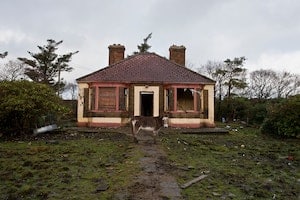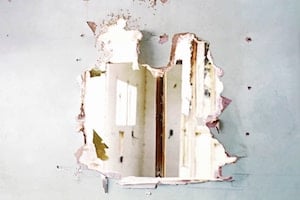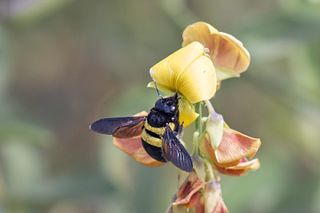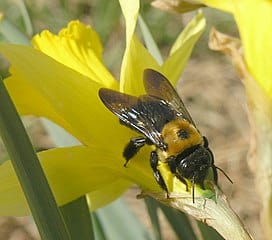If you have been around a barn, deck, or any place where there is exposed wood, you may have probably noticed these big black bees buzzing around or boring into wood. These are known as the carpenter bees who are similar to bumblebees. They do not feed on wood like termites do, but they nest on wood to keep their larvae and food during their hibernation. However, just like any bees, they still have a great role in pollination. This article will discuss the behavior and whether carpenter bees are bad or not.
Are carpenter bees bad? When it comes to your home, carpenter bees can be bad. However, it is a part of their daily lives when they bore holes into wood. Significant damage can be done into your home especially when several bees are drilling into the wood. Carpenter bees usually drill on the same place for years and it can cause different problems on your home.
Table of Contents
Can Carpenter Bees Damage Your Home?

Carpenter bees are large, black, and yellow bees that you can usually see during Springtime. They usually hover around your house or on the underside of your porch. Carpenter bees are usually mistaken for bumblebees, but they differ from their shiny tail section.
Carpenter bees usually target a home with untreated wood. These types of woods are usually on your porches, decks, outbuildings, and any other external structures that you may have at home. These types of bees do not cause serious damage unless large numbers of bees are drilling in the wood of your home for years.
Did you know? The tunnels that are created by carpenter bees are usually about a foot or two in length, and about a nickel in width.
There are a couple of circumstances where carpenter bees can make significant damage to your home. If these bees create a tunnel into a railing on your porch or balcony, it can cause the railing to lose its integrity. This can be very dangerous to the household members and can cause injuries at home. Also, once these bees create their nests on your steps, just like the rail it can cause physical damage.
Another situation that you may encounter is when the carpenter bees bore their nests on the support beams in your home. If this is left untreated, there would be a huge chance of the beams to collapse. Now, it would take a lot of tunnels to compromise a structure, but over time it can weaken the wood.
Aside from structural damage, the nest that carpenter bees create can also cause water damage. Once moisture enters the tunnels, it can speed the rotting of wood. This can be a big problem if the tunnels that the carpenter bees created are on the sidings of your home.
The feces of the carpenter bees can also stain the wood on your home. The tunnels can also attract any insect-eating birds and woodpeckers. It can also attract larvae which can invite more severe damage to your home.
There are a lot of things that you can do to prevent any carpenter bee damage to your home. One of them is to paint all surfaces with a sealing primer and at least two coats of paint. Stains and varnishes are less effective but would also work.
Before painting or sealing, you should fill all the cracks and splintered wood with caulking or putty. Now, if all of these techniques do not work, you might want to look into non-wood materials. Some examples are vinyl, fiber cement, or masonry.
Are Carpenter Bees Destructive?

Carpenter bees are destructive due to the fact that their burrowing habit to protect their offspring can cause damage to the wooden structure in your home. Now, damage done by one bee in a year may not be as significant.
However, if the same tunnel is used over and over again, the hole can extend several feet along the timber which can weaken it. Same as an abundance of bees in one piece of wood can cause a major problem. The carpenter bees also store their food, larvae, and even hibernate during the winter season.
If a lot of bees have already made a single timber as their home, it may be a bit difficult to get rid of them. If you have any existing holes in your home, it is best to close them by the methods that are mentioned below.
Carpenter bees are easy to control by spraying insecticides on the affected area. If there are only one or two galleries that are opened, then an aerosol bee and wasp spray is enough. If a large area is affected, you might want to apply a more persistent insecticide like cyfluthrin.
Once you have done that, it is best to paint or seal the area in order to avoid any instances in the future. Your number one concern when a carpenter bee creates a tunnel is the moisture that can enter the wood that will make it weaker. However, carpenter bees are not as destructive as termites.
Are Carpenter Bees Aggressive?

Just like any other bees, carpenter bees are not aggressive unless they feel threatened. When they feel threatened, they would just buzz in front of your face or around your head.
Did you know? Male carpenter bees do not have any stinger, so you do not need to worry about them stinging you.
Male carpenter bees will feel threatened if you are near their nests. Even though they are harmless, the dive bomb can be a bit intimidating due to their size. They will hover around their nest and dart at any insect that may come near their nests.
Female carpenter bees, on the other hand, have stingers and the ability to sting. It is very unlikely that you would be stung by the female carpenter bees unless you are agitating them or their burrows. They are not usually aggressive since they burrow themselves in wood.
However, the sting of a female carpenter bee is very painful and if the sting is unbearable, it is best to take over the counter antihistamines or painkillers. You might want to see a doctor if any allergic reaction is present.
How Do I Identify Carpenter Bees?

Carpenter bees are usually mistaken for bumblebees since they look similar. They have the same color and you can typically find them in your backyard. The difference that they have with bumblebees is that they have shiny, barebacks whereas a bumblebee has hairy backs.
Despite the carpenter bees and bumblebee’s appearance, their behaviors are totally different. Bumblebees can sting but otherwise harmless, and carpenter bees sting but can damage wooden structures. Male carpenter bees do not have stingers just like male bumblebees.
On the other hand, female carpenter bees do have a stinger but will not harm you. Carpenter bee abdomens are black and hairless. They are usually found near wood, unlike bumblebees and honeybees, which can be found near a beehive.
You can find carpenter bees burrow into the wood, where the female can lay their eggs and raise their larvae. When it comes to size, carpenter bees usually grow half to one inch in body length. Carpenter bees are usually black but some species may have a greenish or purplish color.
For more examples of the different colors that Bees can be, check out our other article here: https://schoolofbees.com/the-color-of-bees/.
The male bee has a yellow face with a white dot on their heads while the females have plain black heads. Male carpenter bees can be territorial and they can buzz around you if you approach them closely. They may sometimes hover from a short distance in front of your face or buzz around your head.
The female carpenter bees lay their eggs in an excavated area called cells or tunnels called galleries. A typical gallery has an entrance hole on the surface of the wood and continuous inwards for a short distance. The female provides a ball of pollen on where the egg is laid.
Male carpenter bees usually come out during Spring season where they seek out female carpenter bees. Once mated, the female carpenter bee closes the galleries by placing a mass of wood pulp where the cells are constructed.
Did you know? Carpenter bees do not swarm and they usually live alone.
What is an Eastern Carpenter Bee?

(Marvin Smith [CC BY-SA 2.0 (https://creativecommons.org/licenses/by-sa/2.0)])
As per Wikipedia, an eastern carpenter bee is also known as Xylocopa Virginia. They can be found through the Eastern United States and into Canada. Just like your ordinary carpenter bee, the eastern carpenter bees also nest in wood.
They can be found in parks, gardens, woods, and fields. Just like other bees, they are adept in finding flowers from where they get their nectars and help with pollination. Even though they pollinate flowers, they also chew on stems, causing more damage to the plant.
These types of bees move fast from one flower to another and harvest from a large area of plants in a short period. The females have strong jaws which help in cutting into wood. Aside from wood, they may also nest in bamboo culms, algae stalks, and any other comparable materials.
The nests may be social or it may contain groups of two to five females, or even solitary.
The female carpenter bees are usually divided into groups and they are primary, secondary, and tertiary:
- Primary bees act as the dominant within the nest and they are in charge of reproduction, providing food, and laying eggs.
- Secondary females are the ones who reinforce helping provide for the larvae or performing nest maintenance.
- Tertiary females rely on the provisions provided by the primary females. They usually wait quietly during overwintering while remaining inactive.
Mating only occurs once a year for the eastern carpenter bees which is during Spring. Their eggs are usually laid in July and the larvae develop until August or September.
Conclusion
To summarize, carpenter bees may be destructive and bad for your home but this is a part of their daily lives. When they burrow in the wood, they usually store their eggs and larvae during Spring. However, they are not as destructive as termites since they do not eat the wood itself. Carpenter bees are similar to bumblebees but they are smaller and have a different color pattern. They also have a different role during their daily lives. Just like any other bees, they would not bother you as long as they do not feel threatened or if you are not within their nest’s vicinity.
